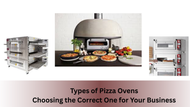Types of Pizza Ovens – Choosing the Right One for Your Buisness
Introduction
Pizza is one of the most universally loved dishes, with countless variations worldwide. Whether you're running a traditional Italian pizzeria, a modern fast-casual concept, or a food truck, the type of pizza oven you use dramatically influences the final product. Choosing the right oven is a major decision for any restaurant. This guide breaks down the most common types of pizza ovens, how they function, and which type of restaurant they best serve.
1. Brick Ovens (Wood-Fired or Gas-Fired)
Function: Brick ovens use wood or gas as a heat source. The interior is typically made of refractory bricks that retain and evenly distribute heat. Temperatures can soar up to 900°F (480°C), which allows pizzas to cook in 90 seconds or less.
Best For: Artisan pizzerias, Italian restaurants, and upscale eateries that prioritize authentic Neapolitan-style pizza.
Advantages:
-
High-heat, quick cooking time
-
Crispy crusts with a unique char
-
Adds smoky flavor (especially wood-fired)
Considerations:
-
Expensive installation
-
Requires more space
-
More labor-intensive and skill-demanding
Restaurant Type: Ideal for restaurants emphasizing authenticity and gourmet flavor profiles. A must-have in fine-dining Italian restaurants.
2. Deck Ovens
Function: These ovens have stone or ceramic decks that radiate heat evenly from below. They’re typically powered by gas or electricity and cook at moderate temperatures (between 500°F and 700°F).
Best For: New York-style pizzerias, bakeries, sandwich shops.
Advantages:
-
Even, consistent heat
-
Allows for high-volume production
-
Can cook multiple types of food (bread, calzones, etc.)
Considerations:
-
Takes time to preheat
-
Larger models require significant space
-
Slower than conveyor or wood-fired ovens
Restaurant Type: A great choice for restaurants with a diverse menu needing versatile commercial restaurant equipment.
3. Conveyor Ovens
Function: Conveyor ovens feature a belt that moves pizzas through a heated chamber. They ensure consistent results with little supervision and are usually electric or gas-powered.
Best For: High-volume pizza chains, delivery-focused kitchens, and quick-service restaurants.
Advantages:
-
High-speed and consistent
-
Easy to operate (great for low-skill environments)
-
Perfect for chain restaurants
Considerations:
-
Less control over browning or charring
-
Larger footprint
-
Not ideal for artisanal styles
Restaurant Type: Excellent for fast-paced environments that need consistency and speed. Conveyor ovens are often seen in franchises and businesses looking for efficiency. If you’re shopping for restaurant supply Fort Worth, consider a conveyor oven if throughput is your priority.
4. Convection Ovens
Function: Convection ovens use a fan to circulate hot air, ensuring even cooking. They are more common in general restaurant kitchens than dedicated pizza shops.
Best For: Cafes, delis, schools, and operations that serve pizza as a side or occasional offering.
Advantages:
-
Compact and affordable
-
Energy-efficient
-
Multi-use (baking, roasting, reheating)
Considerations:
-
Doesn’t replicate traditional pizza textures
-
Not ideal for high-end or high-volume pizza production
Restaurant Type: Great for kitchens with limited space or those buying used restaurant equipment to save on upfront costs.
5. Countertop Pizza Ovens
Function: These compact electric ovens are typically used in small operations or food trucks. They mimic deck ovens on a smaller scale.
Best For: Food trucks, bars, convenience stores, kiosks.
Advantages:
-
Space-saving
-
Affordable
-
Easy to install and move
Considerations:
-
Limited capacity
-
Slower cook times
-
Not suitable for high-volume use
Restaurant Type: Best for operations needing flexibility or those testing the market before upgrading to bigger commercial restaurant equipment.
6. Rotating Pizza Ovens
Function: A hybrid style that includes rotating stone decks inside a dome, combining benefits of deck and conveyor ovens.
Best For: Mid to high-volume pizzerias that want authentic-style pizzas without constant monitoring.
Advantages:
-
Even cooking with minimal effort
-
Can cook multiple pizzas at once
-
Improved consistency
Considerations:
-
More expensive than traditional ovens
-
Requires maintenance for moving parts
Restaurant Type: A strong choice for ambitious restaurants that want artisan quality with efficiency. Consider browsing restaurant supply Fort Worth providers for deals on these specialized ovens.
Buying New vs. Used Pizza Ovens
When equipping a new kitchen or expanding an existing one, deciding between new and used restaurant equipment is crucial.
New Ovens:
-
Warranty and support
-
Latest technology
-
Customizable
Used Ovens:
-
Lower initial cost
-
Faster ROI
-
Good for startups and seasonal use
Make sure to source used equipment from reputable restaurant supply Fort Worth dealers to avoid surprises.
Final Thoughts: Choosing the Right Oven
Ask yourself these key questions before choosing a pizza oven:
-
What style of pizza am I serving?
-
How much space do I have?
-
What’s my daily volume?
-
What’s my budget?
Whether you’re opening a small pizza stand or an upscale Italian trattoria, the right oven is a vital piece of commercial restaurant equipment. Always match the oven to your restaurant’s concept and volume needs.

